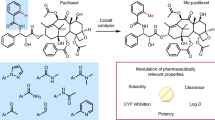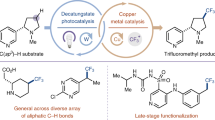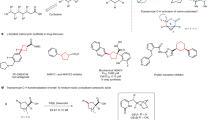Abstract
Frequently referred to as the ‘magic methyl effect’, the installation of methyl groups—especially adjacent (α) to heteroatoms—has been shown to dramatically increase the potency of biologically active molecules1,2,3. However, existing methylation methods show limited scope and have not been demonstrated in complex settings1. Here we report a regioselective and chemoselective oxidative C(sp3)–H methylation method that is compatible with late-stage functionalization of drug scaffolds and natural products. This combines a highly site-selective and chemoselective C–H hydroxylation with a mild, functional-group-tolerant methylation. Using a small-molecule manganese catalyst, Mn(CF3PDP), at low loading (at a substrate/catalyst ratio of 200) affords targeted C–H hydroxylation on heterocyclic cores, while preserving electron-neutral and electron-rich aryls. Fluorine- or Lewis-acid-assisted formation of reactive iminium or oxonium intermediates enables the use of a mildly nucleophilic organoaluminium methylating reagent that preserves other electrophilic functionalities on the substrate. We show this late-stage C(sp3)–H methylation on 41 substrates housing 16 different medicinally important cores that include electron-rich aryls, heterocycles, carbonyls and amines. Eighteen pharmacologically relevant molecules with competing sites—including drugs (for example, tedizolid) and natural products—are methylated site-selectively at the most electron rich, least sterically hindered position. We demonstrate the syntheses of two magic methyl substrates—an inverse agonist for the nuclear receptor RORc and an antagonist of the sphingosine-1-phosphate receptor-1—via late-stage methylation from the drug or its advanced precursor. We also show a remote methylation of the B-ring carbocycle of an abiraterone analogue. The ability to methylate such complex molecules at late stages will reduce synthetic effort and thereby expedite broader exploration of the magic methyl effect in pursuit of new small-molecule therapeutics and chemical probes.
This is a preview of subscription content, access via your institution
Access options
Access Nature and 54 other Nature Portfolio journals
Get Nature+, our best-value online-access subscription
$29.99 / 30 days
cancel any time
Subscribe to this journal
Receive 51 print issues and online access
$199.00 per year
only $3.90 per issue
Buy this article
- Purchase on Springer Link
- Instant access to full article PDF
Prices may be subject to local taxes which are calculated during checkout




Similar content being viewed by others
Data availability
The data that support the findings of this study are available in the Supplementary Information and from the corresponding author upon reasonable request.
References
Schönherr, H. & Cernak, T. Profound methyl effects in drug discovery and a call for new C–H methylation reactions. Angew. Chem. Int. Ed. 52, 12256–12267 (2013).
Cernak, T., Dykstra, K. D., Tyagarajan, S., Vachal, P. & Krska, S. W. The medicinal chemist’s toolbox for late stage functionalization of drug-like molecules. Chem. Soc. Rev. 45, 546–576 (2016); correction 46, 1760 (2017).
Barreiro, E. J., Kümmerle, A. E. & Fraga, C. A. M. The methylation effect in medicinal chemistry. Chem. Rev. 111, 5215–5246 (2011).
Leung, C. S., Leung, S. S. F., Tirado-Rives, J. & Jorgensen, W. L. Methyl effects on protein-ligand binding. J. Med. Chem. 55, 4489–4500 (2012).
Fauber, B. P. et al. Discovery of 1-{4-[3-fluoro-4-((3S,6R)-3-methyl-1,1-dioxo-6-phenyl-[1,2]thiazinan-2-ylmethyl)-phenyl]-piperazin-1-yl}-ethanone (GNE-3500): a potent, selective, and orally bioavailable retinoic acid receptor-related orphan receptor c (RORc or RORγ) inverse agonist. J. Med. Chem. 58, 5308–5322 (2015).
Quancard, J. et al. A potent and selective S1P1 antagonist with efficacy in experimental autoimmune encephalomyelitis. Chem. Biol. 19, 1142–1151 (2012).
Belshaw, P. J., Schoepfer, J. G., Liu, K.-Q., Morrison, K. L. & Schreiber, S. L. Rational design of orthogonal receptor-ligand combinations. Angew. Chem. Int. Ed. Engl. 34, 2129–2132 (1995).
Shogren-Knaak, M. A., Alaimo, P. J. & Shokat, K. M. Recent advances in chemical approaches to the study of biological systems. Annu. Rev. Cell Dev. Biol. 17, 405–433 (2001).
Blakemore, D. C. et al. Organic synthesis provides opportunities to transform drug discovery. Nat. Chem. 10, 383–394 (2018).
White, M. C. & Zhao, J. Aliphatic C–H oxidations for late-stage functionalization. J. Am. Chem. Soc. 140, 13988–14009 (2018).
Campos, K. R. Direct sp3 C–H bond activation adjacent to nitrogen in heterocycles. Chem. Soc. Rev. 36, 1069–1084 (2007).
Cordier, C. J., Lundgren, R. J. & Fu, G. C. Enantioconvergent cross-couplings of racemic alkylmetal reagents with unactivated secondary alkyl electrophiles: catalytic asymmetric Negishi α-alkylations of N-Boc-pyrrolidine. J. Am. Chem. Soc. 135, 10946–10949 (2013).
Beak, P., Basu, A., Gallagher, D. J., Park, Y. S. & Thayumanavan, S. Regioselective, diastereoselective, and enantioselective lithiation-substitution sequences: reaction pathways and synthetic applications. Acc. Chem. Res. 29, 552–560 (1996).
Milligan, J. A., Phelan, J. P., Badir, S. O. & Molander, G. A. Alkyl carbon-carbon bond formation by nickel/photoredox cross-coupling. Angew. Chem. Int. Ed. 58, 6152–6163 (2019).
Paul, A. & Seidel, D. α-Functionalization of cyclic secondary amines: Lewis acid promoted addition of organometallics to transient imines. J. Am. Chem. Soc. 141, 8778–8782 (2019).
Jain, P., Verma, P., Xia, G. & Yu, J.-Q. Enantioselective amine α-functionalization via palladium-catalysed C–H arylation of thioamides. Nat. Chem. 9, 140–144 (2017).
Le, C., Liang, Y., Evans, R. W., Li, X. & MacMillan, D. W. C. Selective sp3 C–H alkylation via polarity-match-based cross-coupling. Nature 547, 79–83 (2017).
Hiemstra, H. & Speckamp, W. N. in Comprehensive Organic Synthesis: Selectivity, Strategy & Efficiency in Modern Organic Chemistry vol. 2 ch.4.5 (eds Trost, B. M. & Fleming, I.) 1047–1082 (Pergamon Press, 1991).
Li, Z., Bohle, D. S. & Li, C.-J. Cu-catalyzed cross-dehydrogenative coupling: a versatile strategy for C–C bond formations via the oxidative activation of sp3 C–H bonds. Proc. Natl Acad. Sci. USA 103, 8928–8933 (2006).
Andrus, M. B. & Lashley, J. C. Copper catalyzed allylic oxidation with peresters. Tetrahedron 58, 845–866 (2002).
Kato, N., Hamaguchi, Y., Umezawa, N. & Higuchi, T. Efficient oxidation of ethers with pyridine N-oxide catalyzed by ruthenium porphyrins. J. Porphyr. Phthalocyanines 19, 411–416 (2015).
Ito, R., Umezawa, N. & Higuchi, T. Unique oxidation reaction of amides with pyridine-N-oxide catalyzed by ruthenium porphyrin: direct oxidative conversion of N-acyl-L-proline to N-acyl-L-glutamate. J. Am. Chem. Soc. 127, 834–835 (2005).
Yoshifuji, S., Tanaka, K.-I., Kawai, T. & Nitta, Y. Chemical conversion of cyclic α-amino acids to α-aminodicarboxylic acids by improved ruthenium tetroxide oxidation. Chem. Pharm. Bull. 33, 5515–5521 (1985).
Kawamata, Y. et al. Scalable, electrochemical oxidation of unactivated C−H bonds. J. Am. Chem. Soc. 139, 7448–7451 (2017).
Annese, C., D’Accolti, L., Fusco, C., Licini, G. & Zonta, C. Heterolytic (2e) vs homolytic (1e) oxidation reactivity: N–H versus C–H switch in the oxidation of lactams by dioxirans. Chem. Eur. J. 23, 259–262 (2017).
Cui, L., Peng, Y. & Zhang, L. A two-step, formal [4+2] approach toward piperidin-4-ones via Au catalysis. J. Am. Chem. Soc. 131, 8394–8395 (2009).
Zhao, J., Nanjo, T., de Lucca, E. C. & White, M. C. Chemoselective methylene oxidation in aromatic molecules. Nat. Chem. 11, 213–221 (2019).
Chen, M. S. & White, M. C. Combined effects on selectivity in Fe-catalyzed methylene oxidation. Science 327, 566–571 (2010).
Gormisky, P. E. & White, M. C. Catalyst-controlled aliphatic C–H oxidations with a predictive model for site-selectivity. J. Am. Chem. Soc. 135, 14052–14055 (2013).
Osberger, T. J., Rogness, D. C., Kohrt, J. T., Stepan, A. F. & White, M. C. Oxidative diversification of amino acids and peptides by small-molecule iron catalysis. Nature 537, 214–219 (2016).
Milan, M., Carboni, G., Salamone, M., Costas, M. & Bietti, M. Tuning selectivity in aliphatic C–H bond oxidation of N-alkylamides and phthalimides catalyzed by manganese complexes. ACS Catal. 7, 5903–5911 (2017).
Nicolaou, K. C., Dolle, R. E., Chucholowski, A. & Randall, J. L. Reactions of glycosyl fluorides. Synthesis of C-glycosides. J. Chem. Soc. Chem. Commun. 1153–1154 (1984).
Posner, G. H. & Haines, S. R. Conversion of glycosyl fluorides into c-glycosides using organoaluminum reagents. Stereospecific alkylation at C-6 of a pyranose sugar. Tetrahedron Lett. 26, 1823–1826 (1985).
Mason, J. D. & Weinreb, S. M. Total syntheses of the monoterpenoid indole alkaloids (±)-alstoscholarisine B and C. Angew. Chem. Int. Ed. 56, 16674–16676 (2017).
Taylor, R. D., MacCoss, M. & Lawson, A. D. G. Rings in drugs. J. Med. Chem. 57, 5845–5859 (2014).
Vitaku, E., Smith, D. T. & Njardarson, J. T. Analysis of the structural diversity, substitution patterns, and frequency of nitrogen heterocycles among U.S. FDA approved pharmaceuticals. J. Med. Chem. 57, 10257–10274 (2014).
Stevens, R. V. Nucleophilic additions to tetrahydropyridinium salts. Applications to alkaloid syntheses. Acc. Chem. Res. 17, 289–296 (1984).
Tomooka, K., Matsuzawa, K., Suzuki, K. & Tsuchihashi, G. I. Lactols in stereoselection 2. Stereoselective synthesis of disubstituted cyclic ethers. Tetrahedron Lett. 28, 6339–6342 (1987).
Lunn, M. R. et al. Indoprofen upregulates the survival motor neuron protein through a cyclooxygenase-independent mechanism. Chem. Biol. 11, 1489–1493 (2004).
Howell, J. M., Feng, K., Clark, J. R., Trzepkowski, L. J. & White, M. C. Remote oxidation of aliphatic C–H bonds in nitrogen-containing molecules. J. Am. Chem. Soc. 137, 14590–14593 (2015).
Prendergast, M. A. et al. Central nicotinic receptor agonists ABT-418, ABT-089, and (–)-nicotine reduce distractibility in adult monkeys. Psychopharmacology 136, 50–58 (1998).
Maryanoff, B. E. et al. Pyrroloisoquinoline antidepressants. Potent, enantioselective inhibition of tetrabenazine-induced ptosis and neuronal uptake of norepinephrine, dopamine, and serotonin. J. Med. Chem. 27, 943–946 (1984).
Sugi, K. et al. Improved synthesis of paroxetine hydrochloride propan-2-ol solvate through one of metabolites in humans, and characterization of the solvate crystals. Chem. Pharm. Bull. 48, 529–536 (2000).
Fujimoto, J. et al. Discovery of 3,5-diphenyl-4-methyl-1,3-oxazolidin-2-ones as novel, potent, and orally available Δ-5 desaturase (D5D) inhibitors. J. Med. Chem. 60, 8963–8981 (2017).
Kitamura, M., Ohmori, K. & Suzuki, K. Divergent behavior of cobalt-complexed enyne having a leaving group. Tetrahedron Lett. 40, 4563–4566 (1999).
Acknowledgements
Financial support for this work was provided by the National Institute of General Medical Sciences (NIGMS) Maximizing Investigators’ Research Award (MIRA; grant R35 GM122525), and from Pfizer to study the modifications of natural products and medicinal compounds. We thank L. Zhu and the University of Illinois School of Chemical Science (SCS) nuclear magnetic resonance (NMR) laboratory for assistance with NMR spectroscopy, and B. Budaitis for checking the procedure in Fig. 3, molecule 8. The Bruker 500-Mz NMR spectrometer was obtained with the financial support of the Roy J. Carver Charitable Trust, Muscatine, IA, USA.
Author information
Authors and Affiliations
Contributions
K.F. and R.E.Q. conducted the experiments and analysed the data. M.C.W., K.F. and R.E.Q. wrote the manuscript. M.C.W., K.F., R.E.Q., J.T.K., M.S.O. and U.R. designed the project. All authors provided comments on the experiments and manuscript during its preparation.
Corresponding author
Ethics declarations
Competing interests
The University of Illinois has filed a patent application (number 16/569,492) on the Mn(CF3PDP) catalyst that lists M.C.W. as an inventor.
Additional information
Publisher’s note Springer Nature remains neutral with regard to jurisdictional claims in published maps and institutional affiliations.
Extended data figures and tables
Supplementary information
Supplementary Information
This file contains the following sections: I. General information; II. Optimization data; III. Preparation and characterization of newly reported starting materials for Figure 3; IV. Experimental procedures and compound characterization for Figure 3; V. Preparation and characterization of newly reported starting materials for Figure 4; VI. Experimental procedures and compound characterization for Figure 4; VII. HPLC traces for the determination of product stereoretention; VIII. References; and IX. Spectral Data.
Rights and permissions
About this article
Cite this article
Feng, K., Quevedo, R.E., Kohrt, J.T. et al. Late-stage oxidative C(sp3)–H methylation. Nature 580, 621–627 (2020). https://doi.org/10.1038/s41586-020-2137-8
Received:
Accepted:
Published:
Issue Date:
DOI: https://doi.org/10.1038/s41586-020-2137-8
This article is cited by
-
Photochemical diversification of strong C(sp3)–H bonds enabled by allyl bromide and sodium fluoride
Nature Synthesis (2023)
-
Late-stage C–H functionalization offers new opportunities in drug discovery
Nature Reviews Chemistry (2021)
-
Stereodefined rhodium-catalysed 1,4-H/D delivery for modular syntheses and deuterium integration
Nature Catalysis (2021)
-
Copper catalyzed late-stage C(sp3)-H functionalization of nitrogen heterocycles
Nature Communications (2021)
-
α-C(sp3)-H Arylation of Cyclic Carbonyl Compounds
Natural Products and Bioprospecting (2021)
Comments
By submitting a comment you agree to abide by our Terms and Community Guidelines. If you find something abusive or that does not comply with our terms or guidelines please flag it as inappropriate.



